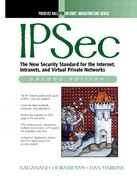The Internet connects millions of people around the world and allows for immediate communication and access to a seemingly limitless amount of information. Data, video, and voice, almost every single type of communication, travels across the Internet. Some of this communication is private.
The language of the Internet is IP, the Internet Protocol. Everything can, and does, travel over IP. One thing IP does not provide, though, is security. IP packets can be forged, modified, and inspected en route. IPSec is a suite of protocols that seamlessly integrate security into IP and provide data source authentication, data integrity, confidentiality, and protection against replay attacks.
With IPSec, the power of the Internet can be exploited to its fullest potential.
Communication is the lifeblood of business. Without a guarantee that a customer's order is authentic, it is difficult to bill for a service. Without a guarantee that confidential information will remain confidential, it is impossible for businesses to grow and partnerships to be formed.
Unless there is a guarantee that records and information can remain confidential, the health care industry cannot utilize the Internet to expand its services and cut its costs.
Personal services, such as home banking, securities trading, and insurance can be greatly simplified and expanded if these transactions can be done securely.
The growth of the Internet is truly dependent on security, and the only technique for Internet security that works with all forms of Internet traffic is IPSec. IPSec runs over the current version of IP, IPv4, and also the next generation of IP, IPv6. In addition, IPSec can protect any protocol that runs on top of IP such as TCP, UDP, and ICMP. IPSec is truly the most extensible and complete network security solution.
IPSec enables end-to-end security so that every single piece of information sent to or from a computer can be secured. It can also be deployed inside a network to form Virtual Private Networks (VPNs) where two distinct and disparate networks become one by connecting them with a tunnel secured by IPSec.
This book discusses the architecture, design, implementation, and use of IPSec. Each of the protocols in the suite commonly referred to as “IPSec” (the Authentication Header, Encapsulating Security Payload, and Internet Key Exchange) is examined in detail. Common deployments of IPSec are discussed and future work on problem areas is identified.
This book is intended for an audience with an interest in network security as well as those who will be implementing secure solutions using IPSec, including building VPNs and e-commerce, and providing end-to-end security. Cryptography and networking basics are discussed in early chapters for those who are neither cryptography nor networking professionals.
This book is split into three parts: overview, detailed analysis, and implementation and deployment issues.
Part One is composed of the first three chapters. Chapter 1 discusses the basic cryptographic building blocks upon which IPSec is built. Symmetric and public-key cryptography and their use for both encryption and authentication are explained. Chapter 2 discusses the basics of TCP/IP and the advantages and disadvantages of implementing security at various layers in the TCP/IP protocol stack. Chapter 3 is an overview of IPSec. The IPSec architecture is discussed and each of the protocols—AH, ESP, and IKE—and their interrelationship is touched upon.
Part Two consists of Chapters 4 through 7. Chapter 4 is a detailed discussion of the IPSec architecture. The basic concepts of IPSec, the different modes, selectors, Security Associations, and security policy, are discussed. Chapters 5 and 6 discuss in detail the two protocols used to protect IP, the Encapsulating Security Payload and the Authentication Header, respectively. Construction and placement of protocol headers are discussed as are input and output processing rules. Chapter 7 is an in-depth discussion of the Internet Key Exchange. The different phases of negotiation, the different exchanges, the various authentication methods, and all the negotiable options are explained.
Part Three is made up of Chapters 8 through 12. Chapter 8 is a discussion of policy and its implication on IPSec. An architecture to support IPSec policy and a policy module is presented. Chapter 9 presents the issues surrounding the implementation of IPSec in a TCP/IP stack, in a platform-independent manner. Chapter 10 discusses different IPSec deployments: end-to-end security, VPNs, and the “road warrior” situation. Chapter 11 discusses how IPSec is deployed to protect a network. Chapter 12 discusses future work items for the IPSec community. These include integrating network layer compression with IPSec, extending IPSec to multicast traffic, issues associated with key recovery, IPSec interaction with the Layer Two Tunneling Protocol (L2TP), and public-key infrastructures.
We would like to thank our editor, Mary Franz, for helping us through the entire process and for giving us this opportunity.
We would like to thank our reviewers: Scott Kelly, Andrew Krywaniuk, and Tim Jenkins. Their comments and suggestions have made this book more readable and complete.
IPSec is the result of the IPSec Working Group of the IETF and we would therefore like to thank Ran Atkinson, Ashar Aziz, Steve Bellovin, Matt Blaze, John Ioannidis, Phil Karn, Steve Kent, Hugo Krawczyk, Hilarie Orman, and Bill Simpson, whose contributions to the development of these protocols have been invaluable.
In the network diagram figures, a dotted line indicates a logical connection (i.e., the two devices are not physically attached), a solid line indicates a physical connection (i.e., there is a physical link between the two devices and they are directly attached, and a pipe indicates a secure connection between two devices.
